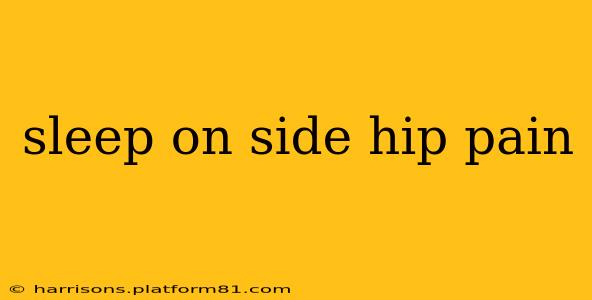Side sleeping is a popular sleep position, but for many, it can lead to hip pain. This discomfort can range from a mild ache to a sharp, debilitating pain, significantly impacting sleep quality and overall well-being. Understanding the causes of hip pain while side sleeping, and implementing effective solutions, is crucial for a good night's rest. This comprehensive guide will explore the common causes, preventative measures, and effective remedies for hip pain experienced while sleeping on your side.
Why Does My Hip Hurt When I Sleep on My Side?
Several factors can contribute to hip pain when sleeping on your side. Identifying the root cause is the first step towards finding relief.
1. Hip Joint Problems:
Conditions like osteoarthritis, bursitis, tendinitis, or labral tears can cause inflammation and pain in the hip joint, exacerbated by pressure during side sleeping. The weight of your body pressing on the hip joint can aggravate existing conditions, leading to increased discomfort.
2. Poor Sleep Posture:
Sleeping with your legs straight and hips tightly aligned can put excessive pressure on your hip joint. Poor posture while sleeping can increase stress and strain, leading to pain and discomfort. This includes the position of your legs and your overall body alignment.
3. Mattress and Pillow Issues:
An unsuitable mattress or pillow can contribute to hip pain. A mattress that is too soft may cause your hip to sink too deeply, putting undue pressure on the joint. Conversely, a mattress that is too firm might not provide adequate support and cause discomfort. Similarly, a pillow that's too high or too low can misalign your spine and put stress on your hips.
4. Pregnancy:
During pregnancy, hormonal changes and the increased weight of the baby can put additional stress on the hip joints. The added pressure from side sleeping during pregnancy can lead to intensified hip discomfort.
5. Underlying Medical Conditions:
Certain medical conditions, such as sciatica, piriformis syndrome, or sacroiliac joint dysfunction, can cause radiating pain that might manifest as hip pain during sleep. These conditions require specific medical attention.
How Can I Reduce Hip Pain When Sleeping on My Side?
Addressing hip pain while side sleeping requires a multifaceted approach:
1. Choose the Right Sleeping Position:
Experiment with slightly altering your sleeping position. Try placing a pillow between your knees and another under your waist to maintain proper spinal alignment and alleviate pressure on your hip. This helps keep your spine neutral and supports your hips and pelvis.
2. Invest in a Supportive Mattress and Pillow:
Consider a medium-firm mattress that provides adequate support without being excessively hard. A supportive pillow can aid in maintaining good spinal alignment. Explore different mattress and pillow types to find what best suits your needs.
3. Use a Body Pillow:
A body pillow can help maintain spinal alignment and distribute your weight more evenly, reducing pressure points on your hip. It offers additional support and cushioning, particularly useful during pregnancy.
4. Stretch and Strengthen Your Hip Muscles:
Regular stretching and strengthening exercises for your hip flexors, glutes, and core muscles can improve hip stability and reduce pain. These exercises help improve your hip's range of motion and build strength. Consult a physical therapist for guidance on appropriate exercises.
5. Consider Pain Relief Measures:
Over-the-counter pain relievers, such as ibuprofen or acetaminophen, can provide temporary relief from hip pain. Applying heat or ice packs to the affected area can also help manage pain and inflammation.
What are Some Other Ways to Alleviate Hip Pain While Sleeping?
This section addresses more specific questions related to alleviating hip pain while sleeping on your side.
What is the best sleeping position to avoid hip pain?
The best sleeping position is one that maintains proper spinal alignment and minimizes pressure on the hip joint. Experiment with different positions and pillows to find what works best for you. Many find relief by sleeping on their side with a pillow between their knees and another supporting their waist.
What kind of mattress is best for hip pain?
A medium-firm mattress generally provides the best support for individuals with hip pain. It prevents your hip from sinking too deeply while still providing enough cushioning to prevent excessive pressure points.
Should I sleep with a pillow between my legs when I sleep on my side?
Yes, placing a pillow between your legs when sleeping on your side is often recommended. This pillow helps keep your hips and spine aligned, reducing pressure on your hip joint and improving overall comfort. Experiment with different pillow thicknesses to find what is most comfortable.
Can physical therapy help with hip pain from sleeping?
Yes, physical therapy can significantly help manage and reduce hip pain caused by sleeping habits. A physical therapist can assess your posture, identify muscle imbalances, and create a personalized exercise program to strengthen your hip muscles and improve flexibility.
By understanding the underlying causes of your hip pain and implementing these strategies, you can significantly improve your sleep quality and reduce or eliminate discomfort. Remember to consult with your doctor or physical therapist for personalized advice if the pain persists or worsens.
